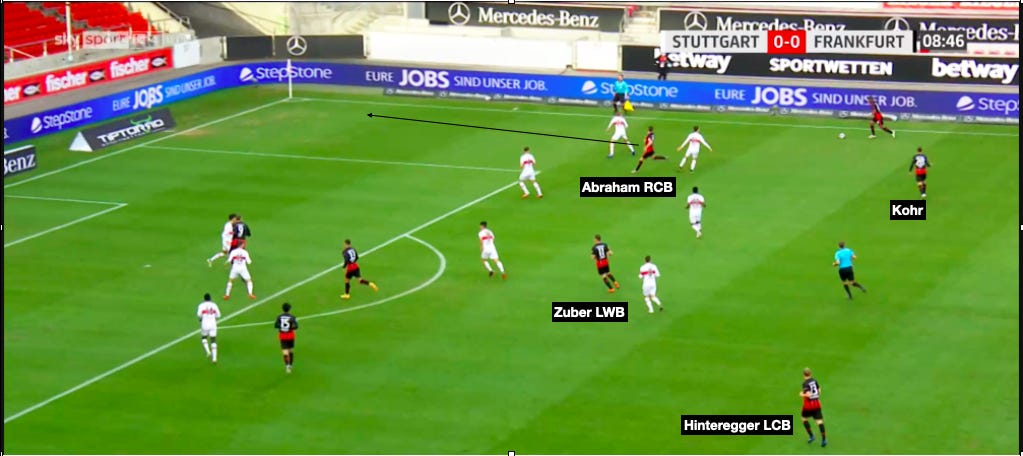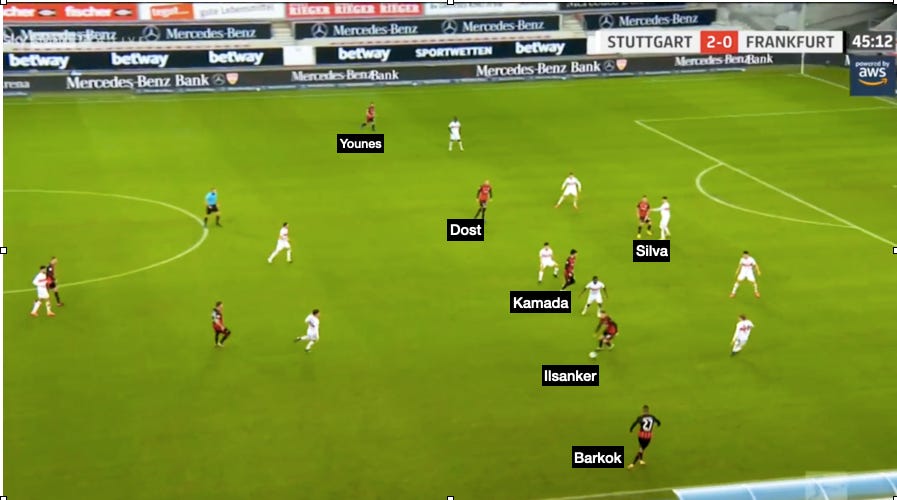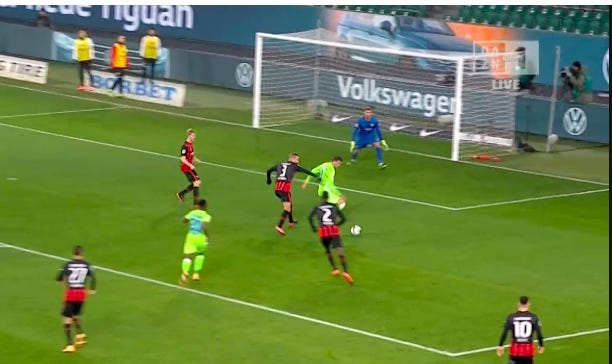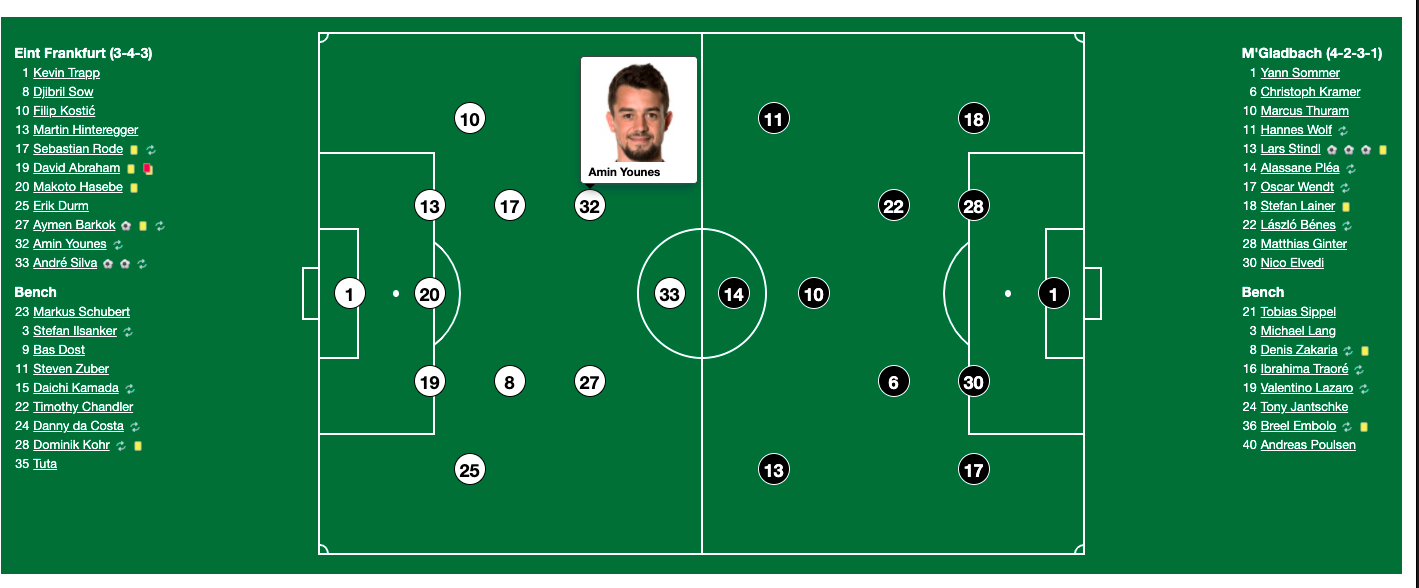The rise of Eintracht part 3: Lost in mediocrity, "schedule" draws, plus the rise of Aymen Barkok and the wait for Amin Younes
examining Frankfurt's progress between the Bayern match and before the change to the double ten
In the previous two parts, I retraced the steps from the 2018\19 season to the first 5 matches of the 2020\21 season, where the 5-0 Bayern loss put a dent into Eintracht’s strong start (8 points from 4 matches). Moreover, Frankfurt would go on to draw 6 of the next 7 matches, albeit as part of a tough schedule against overachievers (Stuttgart/Union Berlin) and genuine top 6 teams (Leipzig, Dortmund and Wolfsburg). Although one has to beware of retrofitting this narrative onto Eintracht’s season, it’s interesting to consider that the aforementioned issues - Ilsanker in the double pivot, Dost up top, not using Barkok and Younes as starters - persisted in the next few matches.
In this next part I will go through this spell and examine whether those issues were fixable at the time and how the coaching staff tried to resolve them via tactical and lineup changes. It should also reveal how Adi Hütter came about making the key tactical change after the Wolfsburg loss: abandoning the 2 striker set up in favor of the Kamada/Younes double pivot behind the consistently excellent Andre Silva, which triggered this current run of excellence. That change and the run will be discussed in the final part of the analysis.
Not all draws are created equal
Frankfurt’s aforementioned run of 5 matches with a draw post Bayern, began promisingly. They outplayed Bremen for much of the match,
but as seen in the images, one mistake in the timing of their counterpressing was enough to concede. After striker Bas Dost did not get the call from the referee, Rode was late in his efforts to get to the ball. Given how synchronized such counterpressing movements must be, Rode’s pressure on the ball carrier triggered Abraham to step to Bittencourt, but he had no chance getting to him. With the RCB leaving his zone free, and the supporting counterpressing players (Kamada/Toure) not being able to win the ball, it allowed Josh Sargent to waltz in for the opener.
One positive sign was the previously mentioned introductions of Barkok and Younes.
They came on at the hour mark with as the attacking wingbacks, and Barkok quickly made an impact, as he won the ball of Mbom high up the pitch, allowing Kamada to set up Andre Silva for a tap-in. Although Silva made the most of that chance, his 7 other attempts were in vain, with his biggest chance coming just before that equalizer.
Thrillers galore, the midfield still remains problematic
The match against the entertaining VfB Stuttgart was a thriller, but one that Eintracht started poorly: Dominik Kohr, who came on at halftime in the Bremen match partnered Ilsanker, but they were often outmatched by Stuttgart’s transition game, which seemed to set up some good pressing traps around the predictable Hasebe to Kamada diagonal.
As you can see neither Kohr nor Ilsanker are in a position to stop a counter - in general Eintracht use at most their 3 CBs (one of which will often be in poor counterpressing access due to needing to play make deep in the opposition half) and their 2 DMs in what’s known as rest defense.
Here is a more poignant example, as David Abraham makes a deep run towards the corner flag, expecting either a cross into the box (with Kamada, Silva and Dost attacking) or a return from Almamy Toure:
Yet, the cross is blocked and Eintracht are now caught in a woeful situation from a counterpressing perspective. You can see just how poorly organized they are with little to no access to the ball, 3 players isolated in the box and on the right wing.
With the channel free, Stuttgart need some clever off-ball movement from Gonzalo Castro and one pass from Kempf to essentially run a counter vs at most 3 Frankfurt players (rest defense)
Though it was perhaps spurred by Castro’s touch being less than optimal Ilsanker opts not to delay and play 3v3 (though I’m not 100% sure on what the principle here is, my guess based on knowing a little about the RB school is that when there’s not at least a couple players with counterpressing access and proper pressure on the ball, he should delay and recover) but to commit himself into a challenge.
That doesn’t go well and suddenly Hasebe and Hinteregger (who ends up defending Silas and Gonzalez’s dribble perfectly) face a 2v3 vs the wily Castro, the speedster Silas and the terrifying Gonzalez. It ends with perhaps the best option from an Eintracht perspective: Nico chooses Castro, who fires wide\over the bar.
That sort of decision-making and general sluggishness would show itself in what was defensively a bad 1st half: Toure ends up giving away the penalty vs Gonzalez, Ilsanker steps out and gets caught halfway for Castro’s goal (Abraham doesn’t look too great here either). Bas Dost also tried to get involved in the second goal at midfield, while both he and Kohr were culpable for missing several big 1st half chances at the other end of the pitch.
You can see just how deep SGE’s strikers were and how little end product the two wingbacks had vs Stuttgart' in the first half by the pass map from https://betweentheposts.net/.
So it’s no surprise that Hütter went for broke down 2-0 at halftime, introducing Younes and Barkok at wingback for Zuber and Touré. Once Gonzales missed his chance from 8 yards following a diagonal run from a nice set piece, Frankfurt’s all out offense stretched VfB’s last line.
Barkok’s aggression and dribbling created the 1st goal, and his 75th minute corner connected with Abraham finding a nice pocket in between the zonal coverage (4 plus 4 in two rows) of Stuttgart. Kevin Trapp’s save on Tanguy Coulibaly made sure that Frankfurt got at least 1 point for their efforts, though with an xG score of 2.3 vs 2.4, the 2-2 draw seemed fair.
Changes in the lineup and some draws vs the big teams without Amin Younes
The conclusions drawn from that Stuttgart match had some consequences for Eintracht’s starting lineup,
with Erik Durm replacing Touré at RWB,
Djibril Sow coming in next to Ilsanker to offer more box to box presence
Filip Kostic fit again to play the full 90 after his 4 minute cameo vs VfB
and Evan Ndicka who missed the first 7 matches after a ligament injury coming in as LCB, making Hinteregger the “Abwerchef” and Hasebe seemingly the odd man out.
Leipzig dominated proceedings, controlling possession and territory, while also holding SGE to just 8 shots, but paid the price for missing their half chances (Olmo, Sorloth, Haidara ) when Barkok raced in after Upamecano misjudged the header and fired past Gulácsi. The second half saw substitute Yussuf Poulsen score an acrobatic goal and miss one chance, while Gulácsi’s 78th minute stop on Andre Silva ensured another draw for Frankfurt. Their 47 pressures in the opponent third were a season high and arguably one of the reasons why Leipzig were not able to create much. It’s worth mentioning that Amin Younes was unavailable due to contracting Covid and would only return as a late substitute vs Wolfsburg.
Already after the Stuttgart match, Frankfurt were developing the reputation as the comeback kings of the Bundesliga - going behind 6 times, but losing just once!, Starting with the same XI from the Leipzig match, they certainly had ample practice after Union was up by 2 after just 5 minutes on MD 9, thanks to two clumsy individual errors by Kevin Trapp (spilling a shot to which his defenders didn’t react, but Robert Andrich did) and Hinteregger, who gave away a penalty vs Taiwo Awoniyi after Frankfurt were carved open centrally in defensive transition.
If the goals they conceded were uncharacteristic, the ones they scored in the first half were vintage Frankfurt: Kamada in transition with an Odegaardesque assist to Silva and Kostic from a free kick finding the Portuguese for a back to the goal looping header to make it 2-2. Silva would “only” get the pre-assist for what looked like the winner in the 78th, as Kamada once again put it on a platter for Bas Dost to finish on the far post, but the Japanese creator might have done more to close down Max Kruse, whose outside of the boot finish is still a goal of the season contender.
The 1:1 draw against Dortmund was similar to the Leipzig match: a good result in a match with 1 big missed chance each (Hummels from a set piece and Barkok blasting it over from ten yards) and a couple nice goals. Frankfurt took the lead via a superb Hinteregger assist to a diagonal run of Kamada, with the Japanese playmaker doing very well to chip it over Bürki, while a brilliant Gio Reyna solo goal saved BVB a point in a match where it was kind of the 343s cancelling each other out.


Frankfurt’s pressing was option-oriented and sought to constrict the field (leaving the ball far side open) in what was a 3313 with some central pressing traps (see the one on Witsel) and turned into man-oriented pressing in a 5122 low block once Dortmund crossed midfield. Their pressure was relentless as Hütter’s XI put up seasonal bests in number of pressures (182).
Without Erling Haaland as the over the top option and facing this compact 5122 that blocked the center, Dortmund often were left to circulate the ball between their 3 CBs and their fullbacks. It speaks volumes of SGE’s pressure that Can/Morey/Zagadou all had pass completions under 75%, meaning that Frankfurt were certainly hard to break down. Sans Raphael Guerreiro’s left wing creativity, other than Jadon Sancho’s dribbling, Dortmund couldn’t create much from open play, Sow (4 tackles) and Ndicka (11 tackles + interceptions combined) put in great shifts. As a result, this was BVB’s shot map, basically all low quality chances….
Changes in possession and no more 2 striker lineup
Already in the Dortmund match, where Frankfurt lined up in a 343 with Kamada and Barkok behind Silva, Hütter seemed to abandon the 2 striker formation. The match against Wolfsburg was an even better example: Frankfurt had to do without Andre Silva and play Dost and Kamada with 3 defensive midfielders in Ilsanker, Sow and Rode. The result was an opening 45 minutes between two highly intense teams producing lots of blocked/wayward shots. Of course, you probably don’t need hindsight to tell you that Wolfsburg were defensively excellent, seeing as they were unbeaten (together with Leverkusen) and conceded 10 goals in 10 matches up to that point, one off the pace set by B04 and RBL’s 9 at the time.
The second half saw Frankfurt not being able to capitalize in transition, with Kamada’s throughball to Sow in the 51st and his key pass to Kostic being their two main chances.
Kostic made matters worse with a horrendous backpass that put in Maxi Philipp only for Trapp to make 2 monster saves on the former BVB striker and Weghorst’s rebound as well. The Serbian winger was still a ways off his best following the injury and you could see this in his numbers. In the 8 games after his injury he had 1 assist and 22 shot creation actions vs his last 7 games of explosion: 2 goals 7 assists and 36 SCAs. We’ll examine why in the tactical change portion of the analysis….
Meanwhile Wolfsburg were yet to employ the “drop one of their DMs into the backline approach to bypass the 2 pressers”, opting for Casteels to go long instead. Eventually, they did grind Eintracht down and held them shotless - aside from the Bas Dost penalty that gave them the lead. Hütter sought to ride it out and kept Wolfsburg to long distance chances until Ilsanker’s handball gave Wout Weghorst a chance to redeem himself from the spot. Unfortunately, it was Ilsanker also at fault for letting Bartosz Bialek to run across him for the eventual winning goal in the 87th minute.
Although Frankfurt brought on da Costa, Barkok and Younes in search of the equalizer and put Hinteregger at striker late, it resulted in zero shots and Wolfsburg staying unbeaten. For Frankfurt meanwhile, it left them with a record of 2 wins 7 draws and 2 losses for just 13 points from 11 matches.
Interestingly, Kamada seems to have been taking some blame for not doing enough defensively and was put on the bench by Hütter for the mid week fixture against Gladbach. He wouldn’t necessarily chalk it up to poor performances but probably as a mix of motivating the Japanese playmaker and also to use the Barkok/Younes double ten as alternatives.
In the next part, I’ll take a look at that major tactical change - the long-awaited, COVID and injury delayed introduction of Amin Younes as a between the lines and deep playmaker, whose emergence ignited Frankfurt’s turnaround. Although like all good stories, they must begin with some adversity: the 3-3 draw against Gladbach, where at 88:52 minutes, Frankfurt were 3-1 up before the hour of Lars Stindl struck!
Thanks for reading
Abel


















